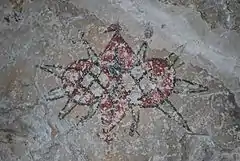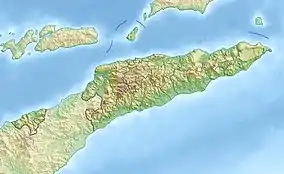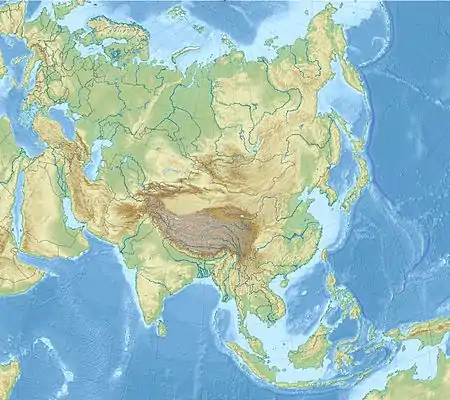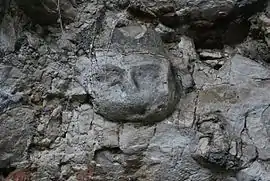 Paintings in Lene Hara cave | |
 Location in East Timor  Lene Hara cave (Asia) | |
| Location | Lautém District |
|---|---|
| Region | eastern tip of East Timor |
| Coordinates | 8°23′32″S 127°17′25″E / 8.39222°S 127.29028°E |

The Lena Hara cave is the main cave of a system of solutional caves in the Lautém District at the eastern tip of East Timor (Timor-Leste), close to the village of Tutuala. Others are Ile Kére Kére and Jerimalai. Lene Hara has provided evidence that Timor has been occupied by humans since at least 35,000 years Before Present[1] and thus is evidence that humans crossed the waters of Wallacea between the Pleistocene continents of Sunda and Sahul.
The cave was first investigated in 1963 by Portuguese anthropologist Antonio de Almeida, when Timor Leste was still under Portuguese rule.[1] Radiocarbon dating of the cave taken from digs beside those investigated by Almeida, by a team led by Sue O'Connor from the Australian National University, shows deposition of shells (trochus and strombus) by transitory inhabitants beginning 35,000 years BP.[1]
O'Connor et al pointed out that the earliest occupation of Australia is dated to around 55,000 BP, so it is unclear whether the early Timor settlers belong to the same wave of colonisation as the first Australian settlers.[1]
O'Connor also reported[2] finding in Lena Hara Holocene fish hooks made from shell, and shell beads.[3]
In May 2009, carved faces were found high in the cave, and have since been dated to 10,000 years. This was reported in the journal Antiquity of February 2011.[4] Paintings in Ile Kére Kére are believed to be 2,000 to 6,000 years old.
In March 2020, 16 hand stencils were discovered at Lene Hara cave, painted in the Pleistocene epoch.[5]
References
- 1 2 3 4 O'Connor, Sue; Spriggs, Matthew; Veth, Peter (2002). "Excavation at Lene Hara Cave establishes occupation in East Timor at least 30,000–35,000 years ago". Antiquity. 76 (291): 45–49. doi:10.1017/S0003598X0008978X. ISSN 0003-598X. S2CID 163141684.
- ↑ O’Connor, Sue; Veth, Peter (2005). "Early Holocene shell fish hooks from Lene Hara Cave, East Timor establish complex fishing technology was in use in Island South East Asia five thousand years before Austronesian settlement". Antiquity. 79 (304): 249–256. doi:10.1017/S0003598X0011405X. ISSN 0003-598X. S2CID 162658431.
- ↑ O'Connor, Sue; Spriggs, Matthew; Veth, Peter (1 January 2002). "Direct dating of shell beads from Lene Hara Cave, East Timor". Australian Archaeology.
- ↑ Scientists find 10,000-year-old stone carvings, ABC News Online, 11 February 2011
- ↑ Christopher D. Standish; et al. (2020). "Hand stencil discoveries at Lene Hara Cave hint at Pleistocene age for the earliest painted art in Timor-Leste". ScienceDirect. doi:10.1016/j.ara.2020.100191.
Further reading
- Protecting the rock art of Tutuala / Proteje Arte Fatuk Tutuala nian (Report) (in English and Tetum). Jakarta: UNESCO. 2017. JAK/2018/PI/H/9. Retrieved 9 July 2022.
External links
![]() Media related to Lene Hara at Wikimedia Commons
Media related to Lene Hara at Wikimedia Commons